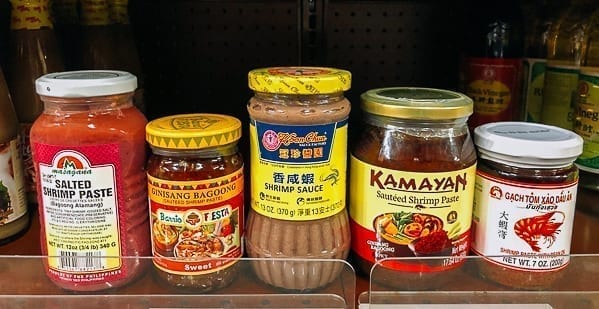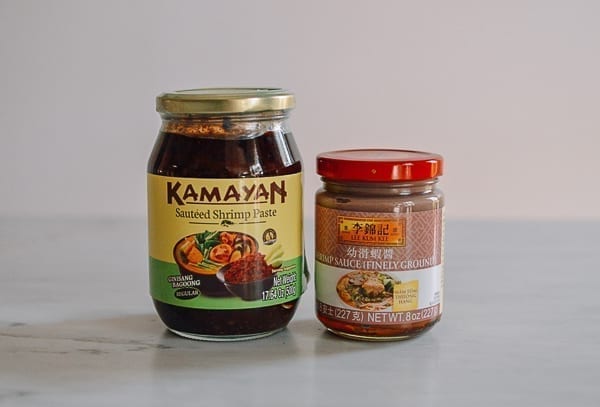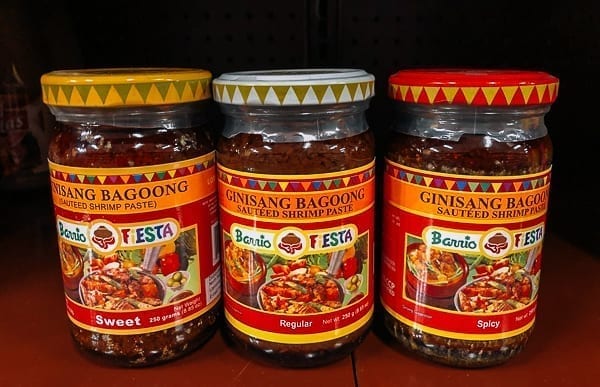Hey there! I’ve been cooking with shrimp paste for years, and lemme tell you – this stuff is like a secret weapon in Southeast Asian cooking. Today, I’m gonna share everything I know about using this powerful ingredient that can take your dishes from meh to amazing!
What the Heck is Shrimp Paste Anyway?
Shrimp paste is this super concentrated condiment made from fermented ground shrimp and salt. In Southeast Asia, people call it different names:
- Belacan in Malaysia
- Terasi in Indonesia
- Kapi in Thailand
- Bagoong in Philippines
The smell might knock your socks off at first (no joke!), but don’t let that scare you away Its intense umami flavor is exactly what gives many Southeast Asian dishes their authentic taste.
How to Pick and Store Your Shrimp Paste
Choosing Good Quality Paste
When shopping, here’s what I look for:
- Sealed jars or plastic containers (no loose wrapping!)
- Smooth, consistent texture
- Color ranging from pinkish to deep brown
- Strong but not rotten smell
- Simple ingredients list (just shrimp and salt)
Storage Tips
- Keep it in an airtight container in the fridge
- Make sure lid is tightly sealed after each use
- Can last several months when stored properly
- Label container with purchase date (trust me on this one!)
Getting Started: Basic Cooking Tips
Before You Cook
- Start with tiny amounts (like 1/4 teaspoon) – you can always add more!
- Always fry or roast it first:
- Heat a small pan with oil
- Fry paste for 10-30 seconds until fragrant
- This mellows the intensity and releases good flavors
Balancing The Funk
To balance shrimp paste’s strong taste
- Add acidic ingredients like lime juice or tamarind
- Include a pinch of sugar
- Mix with fresh aromatics (garlic, shallots, ginger)
- Blend with chilies for heat
Awesome Ways to Use Shrimp Paste
In Curries
- Fry paste with curry spices
- Add coconut milk
- Simmer with your choice of protein
- Taste and adjust seasonings
For Killer Stir-Fries
- Heat wok until smoking
- Fry paste briefly
- Add other ingredients
- Keep stirring until done
Making Dipping Sauces
Mix together
- 1/4 tsp shrimp paste
- Chilies
- Lime juice
- Palm sugar
- Fish sauce
Perfect for fresh veggies or grilled meats!
My Favorite Quick Recipes
Simple Fried Rice
Ingredients:- 3 cups cooked rice- 1/4 tsp shrimp paste- 2 eggs- Veggies of choice- 2 tbsp oil- Salt to tasteInstructions:1. Fry shrimp paste in oil2. Add beaten eggs3. Toss in rice and veggies4. Stir-fry until hotEasy Noodle Upgrade
Ingredients:- Your favorite noodles- 1/8 tsp shrimp paste- Garlic and shallots- Green onions- Soy sauceInstructions:1. Cook noodles2. Fry paste with aromatics3. Toss everything together4. Garnish with green onionsPro Tips and Tricks
- Don’t Skip the Frying Step: Raw shrimp paste is way too strong
- Less is More: You can always add more, but can’t take it out!
- Mix with Other Sauces: Try blending with oyster sauce or soy sauce
- Keep It Fresh: Always use clean utensils to prevent contamination
Common Mistakes to Avoid
- Using too much (seriously, start small!)
- Not frying it first
- Adding it raw to dishes
- Storing at room temperature
- Using old or expired paste
When to Skip the Shrimp Paste
Some folks might need to avoid shrimp paste:
- People with shellfish allergies
- Vegetarians/vegans
- When cooking for mixed dietary groups
Try these substitutes instead:
- Miso paste
- Fermented soybean paste
- Vegetarian stir-fry sauce
Wrapping It Up
Shrimp paste might seem scary at first, but it’s actually pretty easy to use once you get the hang of it. Start small, experiment a bit, and before you know it, you’ll be cooking up amazing Southeast Asian dishes like a pro!
Remember – the key is balance. Too little won’t give you that authentic taste, too much might overwhelm everything else. Practice makes perfect, so don’t be afraid to play around with it!
Got questions about using shrimp paste? Drop ’em in the comments below – I’d love to help you out! Happy cooking, friends!

How Is It Used?
Many Cantonese dishes, most commonly clay pot dishes like stewed eggplant and tofu use shrimp sauce as the primary flavor agent. Pungent and flavorful, these dishes are among our family favorites.
Shrimp sauce can also be used as a condiment for dishes like stir-fried conch with vegetables and fried tofu. The shrimp paste used in these Cantonese dishes is called ham ha, and can be used sparingly. A teaspoon is more than enough for a stir-fry that serves 4.
Another popular form of shrimp paste is belacan in Malaysia. It comes in hard-pressed solid bricks, and is used in many Malaysian dishes. One of our favorites is a simple dish of stir-fried water spinach with shrimp paste.
Shrimp paste can be found in Asian markets, especially those with a good selection of Southeast Asian ingredients. It can be one of the more difficult-to-find ingredients in our glossary, but it can be ordered online in a pinch.

Dried shrimp paste does not have to be refrigerated. Store it in an airtight container in a cool, dry place.
Jarred shrimp paste is also salted and fermented, so it will last a while without refrigeration. However, we find this ingredient doesn’t get used as often in our experience, so we like to keep it in the refrigerator to ensure it keeps longer. It can last over a year in the fridge.
Just make sure it is in a tightly sealed container, or you might get a shrimp-scented refrigerator!
What Is Shrimp Paste?
Shrimp paste or shrimp sauce (xiā jiàng, 虾酱) is made from crushed or ground shrimp. Like fish sauce, it is salted and fermented. The flavor is similar to fish sauce, except it is quite a bit stronger and, well…shrimpier.
It can come in different forms, from liquid sauces and thicker pastes to solid, dried blocks, depending on which culinary tradition the paste comes from.
Each unique paste has a different name and different applications, including ham ha in Cantonese (Southern China/Hong Kong), belacan (Malaysia), terasi (Indonesia), kapi (Thailand), mắm tôm (Vietnam), bagoong (Phillippines), and probably more that we haven’t heard of!
These shrimp pastes can vary widely when it comes to salt level, smell, texture, and color.

Some brands even make sweet, regular, and spicy versions, like this Filipino brand:

This Filipino Ingredient is a MUST TRY
FAQ
What is the best way to use shrimp paste?
As for usage, we use shrimp paste for dipping. Not straight from the bottle, but whisking it until ‘bubble’ stage with some lime juice, sugar and chili slices. It’s delicious for fried tofu, steamed meat etc.
What is the purpose of shrimp paste?
The salty shrimp paste is the key to the flavor of many famous Vietnamese dishes. Various types of shrimp paste can be used as a marinade or added to already-cooked foods, including stir-fries and noodle soups.
How much shrimp paste should I use?
A teaspoon is more than enough for a stir-fry that serves 4. Another popular form of shrimp paste is belacan in Malaysia. It comes in hard-pressed solid bricks, and is used in many Malaysian dishes.
How long does shrimp paste last in the fridge?
How to use shrimp paste in cooking?
By adjusting the intensity of shrimp paste in your recipes, you can tailor the taste to your liking and create dishes that perfectly balance the unique flavors of this beloved ingredient. In conclusion, understanding how to use shrimp paste in cooking is a valuable skill that can elevate your culinary creations to new heights.
What are the best shrimp paste recipes?
Here are five shrimp paste recipes that showcase the now-mainstream staple. Shrimp Pad Thai: There’s three times the shrimp in this perfect pad Thai: The recipe calls for head-on fresh shrimp, fried dried shrimp, and shrimp paste. Pork Satay: Chef Bryant Ng’s version of pork satay is perfectly balanced and deliciously aromatic.
What can I eat with shrimp paste?
Here are serving suggestions and recipe ideas to inspire you: Toss pasta or noodles with a teaspoon of shrimp paste, garlic, oil and veggies for a quick weeknight meal. Make shrimp paste chile dip by blending with red chiles, lime juice and palm sugar. Serve with fresh vegetables or prawn crackers.
Can shrimp paste be used as a condiment?
Shrimp paste can be used as a condiment, particularly when mixed with other ingredients such as lime juice, sugar, and chilies to create a flavorful dipping sauce or accompaniment to grilled meats and seafood. Watch this awesome video to spice up your cooking!
What can I add to shrimp paste?
Consider adding a squeeze of lime or lemon juice to your dish to brighten the flavors and create a harmonious balance. Adding aromatics: Aromatics like garlic, shallots, or ginger can complement the savory notes of shrimp paste.
